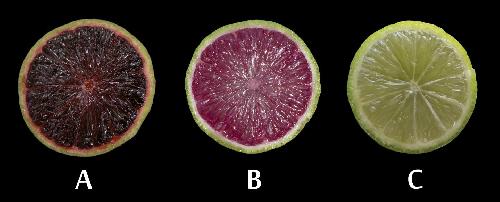Anthocyanins, pigments that give plants their red, blue, or purple hues, are not typically produced in citrus fruits grown under tropical or subtropical conditions.
Now, scientists have genetically engineered a lime that contains anthocyanins, which they say has several potential benefits. Manjul Dutt, Daniel Stanton, and Jude Grosser, from the Citrus Research and Education Center at the University of Florida, say that the discovery will allow the cultivation of new citrus fruits in the major subtropical citrus belt and/or the production of ornamental plants, depending on the cultivar.
The process also creates opportunities for novel fruit, leaf, and flower colors to be produced by regulating anthocyanin biosynthesis.
In the study in the Journal of the American Society for Horticultural Science, Dutt, Stanton, and Grosser reported on experiments in which they achieved production of anthocyanins in 'Mexican' lime, a citrus cultivar that does not produce anthocyanin naturally. The scientists produced transgenic 'Mexican' lime (Citrus aurantifolia Swingle) plants expressing either a myb-related anthocyanin biosynthesis regulatory gene cloned from the red grape 'Ruby Seedless' or from the 'Moro' blood orange.
The experiments resulted in anthocyanin pigmentation in the leaves, stems, flowers, and fruit. The researchers observed an increased pigmentation of the outer layer(s) of stem tissue in 'Mexican' lime overexpressing the VvmybA1 (from red grape), whereas lower anthocyanin levels were observed in plants overexpressing Ruby (from blood orange). Enhanced pigmentation was also observed in the young leaves; however, pigment intensity levels decreased as the leaves matured. Flower color ranged from light pink to fuchsia. The fruit pulp of several of the lime lines were maroon, similar to a blood orange.

"Our report outlines the successful production of transgenic 'Mexican' lime plants, resulting in the production of anthocyanins in a citrus cultivar that does not produce anthocyanin naturally," the authors said. "These plants exhibited unique leaf pigmentation, flower coloration, and pulp enhanced by anthocyanin overproduction."
The authors said the newly developed limes could be used as novel ornamental plants or, after rigorous testing, released to fresh fruit markets because of their potential health benefits. They added that the study "opens up the possibility" of developing modified sweet orange or grapefruit cultivars that are anthocyanin-rich and adapted to subtropical environments.





Comments